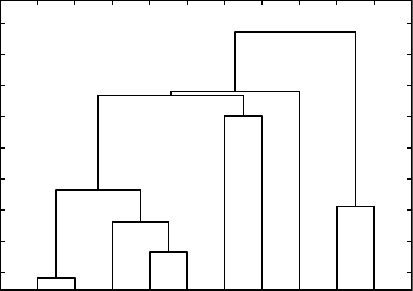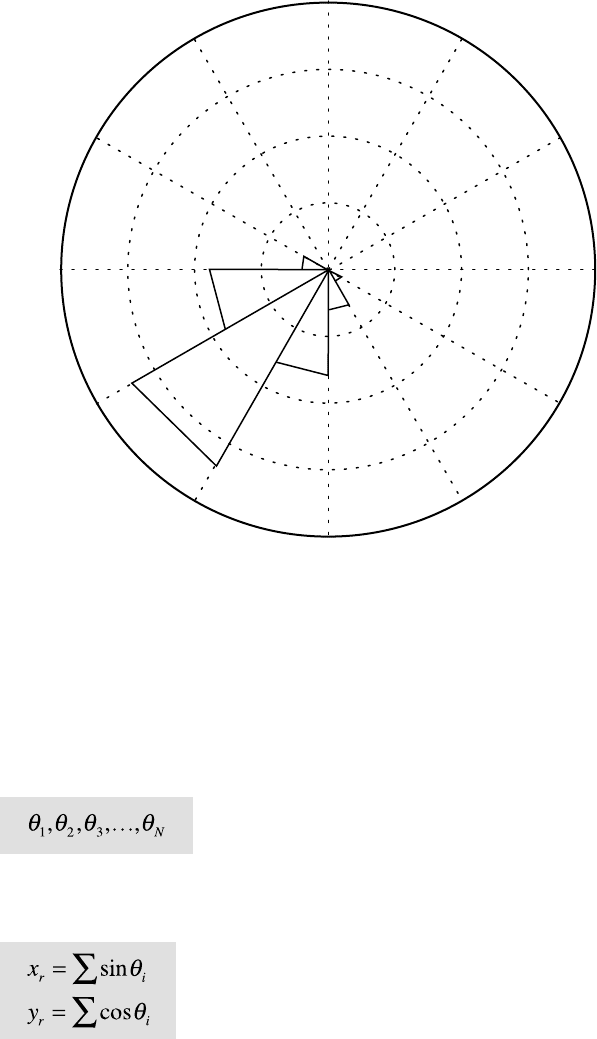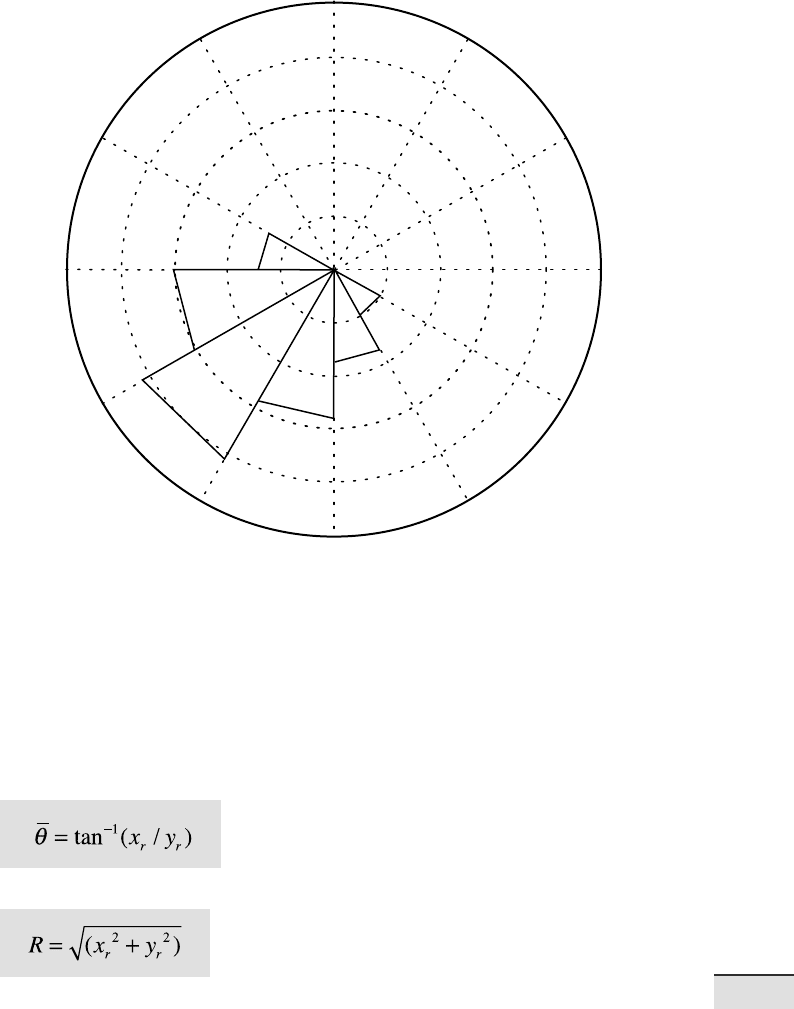Trauth M.H., MATLAB® Recipes for Earth Sciences, Third edition
Подождите немного. Документ загружается.


308 9 MULTIVARIATE STATISTICS
Sample No.
Distance
2 9 1 810 3 4 5 6 7
0.06
0.08
0.10
0.12
0.14
0.16
0.18
0.20
0.22
Fig. 9.6 Output of the cluster analysis. e dendrogram shows clear groups consisting of
samples 1, 2, 8, 9 and 10 (the magmatic source rocks), samples 3, 4 and 5 (the magmatic dyke
containing ore minerals), and samples 6 and 7 (the sandstone unit).
row (link) between objects (or samples) 1 and 2 has the smallest distance,
corresponding to the highest similarity. In our example, samples 2 and 9
have the smallest separation distance of 0.0564 and are therefore grouped
together and given the label 11, i.e., the next available index higher than the
highest sample index 10. Next, samples 8 and 10 are grouped to 12 since
they have the second lowest di erence of 0.0730. e next row shows that
the new group 12 is then grouped with sample 1, which have a di erence
of 0.0923, and so forth. Finally, we visualize the hierarchical clusters as a
dendrogram which is shown in Figure 9.6.
dendrogram(Z);
xlabel('Sample No.')
ylabel('Distance')
box on
Clustering nds the same groups as the principal component analysis. We
observe clear groups consisting of samples 1, 2, 8, 9 and 10 (the magmatic
source rocks), samples 3, 4 and 5 (the hydrothermal vein) and samples 6
and 7 (the sandstone). One way to test the validity of our clustering result is
to use the cophenet correlation coefficient:
cophenet(Z,Y)
ans =
0.7579

RECOMMENDED READING 309
9 MULTIVARIATE STATISTICS
e result is convincing since the closer this coe cient is to one, the better
is the cluster solution.
Recommended Reading
Aitchison J (1984) e Statistical Analysis of Geochemical Composition. Mathematical
Geology 16(6):531–564
Aitchison J (1999) Logratios and Natural Laws in Compositional Data Analysis. Mathematical
Geology 31(5):563–580
Birks HJB, Gordon AD (1985) Numerical Methods in Quaternary Pollen Analysis. Academic
Press, London
Brown CE (1998) Applied Multivariate Statistics in Geohydrology and Related Sciences.
Springer, Berlin Heidelberg New York
Hermanns R, Trauth MH, McWilliams M, Strecker M (2000) Tephrochronologic
Constraints on Temporal Distribution of Large Landslides in NW-Argentina. Journal
of Geology 108:35–52
Hotelling H (1931) Analysis of a Complex of Statistical Variables with Principal Components.
Journal of Educational Psychology 24(6):417–441
Pawlowsky-Glahn V (2004) Geostatistical Analysis of Compositional Data – Studies in
Mathematical Geology. Oxford University Press, Oxford
Pearson K (1901) On lines and planes of closest t to a syst em of poi nt s in sp ace. Ph ilo sophic al
Magazine and Journal of Science 6(2):559–572
Reyment RA, Savazzi E (1999) Aspects of Multivariate Statistical Analysis in Geology.
Elsevier Science, Amsterdam
e Mathworks (2010) Statistics Toolbox – User’s Guide. e MathWorks, Natick, MA
Trauth MH, Bookhagen B, Mueller A, Strecker MR (2003) Erosion and climate change in
the Santa Maria Basin, NW Argentina during the last 40,000 yrs. Journal of Sedimentary
Research 73 (1):82–90
Westgate JA, Shane PAR, Pearce NJG, Perkins WT, Korisettar R, Chesner CA, Williams
MAJ, Acharyya SK (1998) All Toba Tephra Occurrences Across Peninsular India Belong
to the 75,000 yr BP Eruption. Quaternary Research 50:107–112

10 STATISTICS ON DIRECTIONAL DATA
10 Statistics on Directional Data
10.1 Introduction
Methods for analyzing circular and spherical data are widely used in earth
sciences. For instance, structural geologists measure and analyze the ori-
entation of slickensides (or striae) on fault planes. Circular statistics is also
common in paleomagnetic applications. Microstructural investigations
include the analysis of grain shapes and quartz c-axis orientations in thin
sections. Paleoenvironmentalists also reconstruct paleocurrent directions
from fossil alignments (Fig. 10.1). In principle, two types of directional data
exist in earth sciences: directional data sensu stricto, and oriented data.
Directional data have a true polarity, such as the paleocurrent direction of a
river as documented by ute marks, or the ow direction of a glacier as in-
dicated by glacial striae. Oriented data describe axial data and lines without
any sense of direction, such as the orientation of joints.
MATLAB is not the rst choice for analyzing directional data since it
does not provide the relevant functions, such as an algorithm to compute
the probability distribution function of a von Mises distribution or to run a
Rayleigh’s test for the signi cance of a mean direction. Earth scientists have
therefore developed numerous stand-alone programs with which to ana-
lyze such data, e. g., the excellent so ware developed by Rick Allmendinger,
available for Mac OS 9 and OS X as well as for Microso Windows:
http://www.geo.cornell.edu/geology/faculty/RWA/programs.html
e following tutorial on the analysis of directional data is independent of
these tools. It provides simple MATLAB codes to display directional data, to
compute the von Mises distribution and to run simple statistical tests. e
rst section introduces rose diagrams as the most widely used method to
display directional data (Section 10.2). With a similar concept to Chapter 3
on univariate statistics, the next sections are on empirical and theoretical
distributions to describe directional data (Sections 10.3 and 10.4). e last
three sections then describe the three most important tests for directional
M.H. Trauth, MATLAB
®
Recipes for Earth Sciences, 3rd ed.,
DOI 10.1007/978-3-642-12762-5_10, © Springer-Verlag Berlin Heidelberg 2010

312 10 STATISTICS ON DIRECTIONAL DATA
Fig. 10.1 Orthoceras fossils from an outcrop Neptuni Acrar near Byxelkrok on Öland,
Sweden. Orthoceras is a cephalopod with a straight shell and that lived in the Ordovician
era, about 450 million years ago. Such elongated, asymmetric objects tend to orient
themselves in the hydrodynamically most stable position. e fossils can therefore indicate
paleocurrent directions. e statistical analysis of cephalopod orientations at Neptuni
Acrar reveals a signi cant southerly paleocurrent direction, which is in agreement with the
paleogeographic reconstructions.
data, these being the tests for randomness of directional data (Section 10.5),
for the signi cance of a mean direction (Section 10.6), and for the di erence
between two sets of directional data (Section 10.7).
10.2 Graphical Representation
e classic way to display directional data is the rose diagram. A rose dia-
gram is a histogram for measurements of angles. In contrast to a bar histo-
gram with the height of the bars proportional to frequency, the rose diagram
comprises segments of a circle with the radius of each sector being propor-
tional to the frequency. We use synthetic data to illustrate two types of rose
diagrams used to display directional data. We load a set of directional data
from the le directional_1.txt.

10.3 EMPIRICAL DISTRIBUTIONS 313
10 STATISTICS ON DIRECTIONAL DATA
clear
data_degrees_1 = load('directional_1.txt');
e data set contains forty measurements of angles, in degrees. We use the
function
rose(az,nb) to display the data. e function plots an angle
histogram for the angles
az in radians, where nb is the number of classes.
However, since the original data are in degrees, we need to convert all mea-
surements to radians before we plot the data.
data_radians_1 = pi*data_degrees_1/180;
rose(data_radians_1,12)
e function rose counts in a counterclockwise direction in which zero de-
grees lies along the x-axis of the coordinate graph. In geosciences, however,
0° points due north, 90° points due east and the angles increase clockwise.
e command
view rotates the plot by +90° (the azimuth) and mirrors the
plot by –90° (the elevation) (Fig. 10.2).
rose(data_radians_1,12)
view(90,-90)
e area of the arc segments increases with frequency. In a nal modi -
cation the rose diagram is therefore scaled to the square root of the class
frequency. e function
rose does not allow plotting of the square root of
the frequencies by default, but the corresponding le
rose.m can be eas-
ily modi ed as follows. A er the histogram of the angles is computed in
line 58 by using the function
histc, add a line with the command nn =
sqrt(nn); which computes the square root of the frequencies nn. Save
the modi ed function as le
rose_sqrt.m and apply the new function to
the data set.
rose_sqrt(data_radians_1,12)
view(90,-90)
is plot satis es all conventions in geosciences (Fig. 10.3).
10.3 Empirical Distributions
is section introduces statistical measures used to describe empirical dis-
tributions of directional data. e characteristics of directional data are de-
scribed by measures of central tendency and dispersion, similar to the sta-
tistical characterization of univariate data sets (Chapter 3). Assume that we
have collected a number of angular measurements such as fossil alignments.

314 10 STATISTICS ON DIRECTIONAL DATA
5
10
15
90
120
20
60
30
0
330
300
270
240
210
180
150
Fig. 10.2 Rose diagram to display directional data using the function rose. e radii of
the area segments are proportional to the frequencies for each class.
e collection of data can be written as
containing N observations θ
i
. Sine and cosine values are computed for each
direction θ
i
to compute the resultant or mean direction for the set of an-
gular data.

10.3 EMPIRICAL DISTRIBUTIONS 315
10 STATISTICS ON DIRECTIONAL DATA
1
2
4
90
120
5
60
30
0
330
300
270
240
210
180
150
3
Fig. 10.3 Modi ed rose diagram to display directional data using the function rose_
sqrt. In this version of rose, 0° points due north, 90° points due east and the angles
increase clockwise. e plot scales the rose diagram to the square root of the class frequency.
e area of the arc segments now increases with frequency.
e resultant direction of the data set is
e length of the resultant is
e resultant length clearly depends on the dispersion of the data.
Normalizing the resultant length to the number of observations yields the

316 10 STATISTICS ON DIRECTIONAL DATA
1
=30°
2
=170°
3
=40°
Short resultant vector
1
=80°
2
=130°
3
=60°
Long resultant vector
θ
θ
θ
θ
θ
θ
Fig. 10.4 Resultant direction of directional data. e resultant length R of a sample
decreases with increasing dispersion of the data θi..
mean resultant length.
e value of the mean resultant length decreases with increasing disper-
sion (Fig. 10.4). e di erence between one and the mean resultant length is
therefore o en used as a measure of dispersion for directional data,
which is the circular variance.
e following example illustrates the use of these parameters by means
of synthetic directional data. We rst load the data from the le direction-
al_1.txt and convert all measurement to radians.
clear
data_degrees_1 = load('directional_1.txt');
data_radians_1 = pi*data_degrees_1/180;
We now calculate the resultant vector R. Firstly, we compute the x and y
components of the resultant vector.
x_1 = sum(sin(data_radians_1))
y_1 = sum(cos(data_radians_1))

10.3 EMPIRICAL DISTRIBUTIONS 317
10 STATISTICS ON DIRECTIONAL DATA
x_1 =
-24.3898
y_1 =
-25.9401
e mean direction is the inverse tangent of the ratio of x and y.
mean_radians_1 = atan(x_1/y_1)
mean_degrees_1 = 180*mean_radians_1/pi
mean_radians_1 =
0.7546
mean_degrees_1 =
43.2357
is result suggests that the resultant vector R is around 0.75 radians or 43°.
However, since both x and y are negative, the true value of
mean_degrees
is located in the third quadrant and we therefore add 180°.
mean_degrees_1 = mean_degrees_1 + 180
mean_degrees_1 =
223.2357
which results in a mean direction of around 223°. e length of this vector
is the absolute value of the vector, which is
R_1 = sqrt(x_1^2 + y_1^2)
R_1 =
35.6055
e resultant length depends on the dispersion of the directional data.
Normalizing the resultant length to the sample size yields the mean resul-
tant length of
Rm_1 = R_1 / (length(data_radians_1))
Rm_1 =
0.8901
Higher Rm suggests less variance. We then compute the circular variance
sigma, which is
sigma_1 = 1 - Rm_1
sigma_1 =
0.1099
